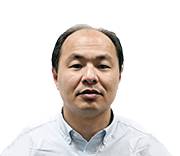One of the hallmarks of cancer cells is their refusal to die. Researchers have found that not only do they circumvent normal end-of-life cell death, but they also dodge another type of immunogenic cell death, called “necroptosis.” A researcher at the University of Texas Southwestern Medical Center is trying to better understand this type of cell death, in an effort to figure out how to activate it to kill cancer.
Zhigao Wang was retained as a faculty member in 2012 at UT Southwestern, where he was a postdoctoral fellow, with the help of a First-Time Tenure-Track Award from CPRIT. He joined the faculty of the molecular biology department.
Read More
One of the hallmarks of cancer cells is their refusal to die. Researchers have found that not only do they circumvent normal end-of-life cell death, but they also dodge another type of immunogenic cell death, called “necroptosis.” A researcher at the University of Texas Southwestern Medical Center is trying to better understand this type of cell death, in an effort to figure out how to activate it to kill cancer.
Zhigao Wang was retained as a faculty member in 2012 at UT Southwestern, where he was a postdoctoral fellow, with the help of a First-Time Tenure-Track Award from CPRIT. He joined the faculty of the molecular biology department.
During necroptosis, dying cells rupture and release their contents. This sends signals to the immune system to slurp up the damaged cells and excrete them from the body. Excess necroptosis can be a problem in some diseases, like stroke or heart attack, when cells die from inadequate blood supply; or sepsis, when massive infection causes organ damage or even death.
Wang hopes that by better understanding the mechanisms of necroptosis, researchers can both stop it to protect tissues from harm in these cases, and also reactivate it to kill cancer cells.
In order to either avert or promote cell death, Wang is screening large numbers of biologically active molecules to ascertain their effects. He’s found about 20 compounds that can block cell death, and is working on the two most promising. So far, he has found that using these compounds, he can prevent sepsis in animal models.
For inducing cell death, Wang is screening extracts used in traditional Chinese medicine. One of the people who joined his lab is an expert in Chinese medicine and brought 300 extracts with her from China for study. So far, they have found one extract that is extremely effective at killing cancer cells, and are subjecting it to further study in order to find out how it works.
“In Chinese traditional medicine, they use a combination of extracts to treat a patient,” Wang says. “For our purposes, we want to dissect out the individual compounds.”
Knowing more about the detailed mechanisms of necrotic cell death has enabled Wang to make some insights that may eventually lead to more effective treatments for some cancers. He found that cancers that have high levels of a particular protein involved in cell death, called MLKL, are potentially susceptible to a type of chemotherapy that increases MLKL’s ability to clump together. It’s this clumping that leads to the rupture of the cell. The chemo therapy, called thioredoxin inhibitor, has not been broadly effective in clinical trials but Wang thinks that using it to target cancers that have high levels of MLKL will lead to much better results.
Eventually, Wang hopes that by inducing necroptosis at the same time as using immunotherapy to rev up a patient’s immune system will knock out cancer with a potent one-two knockout punch.
Wang credits CPRIT for providing the startup funds he needed to conduct biomedical screens, which included technology that otherwise would have been prohibitively expensive. “Without CPRIT I would not have been able to hire the people I’ve hired,” he says, “and it enabled me to try things I never would have been able to try, like screening Chinese traditional medicines.”
He has received nearly $1.4 million in follow-on funding for his research, from the Welch Foundation and National Institutes of Health.
Wang studied biochemistry at Wuhan University in China before coming to UT Southwestern, first as a graduate student in molecular biology in 1998, and remaining as a postdoctoral fellow in biochemistry after receiving his Ph.D. in 2004.
Read Less

